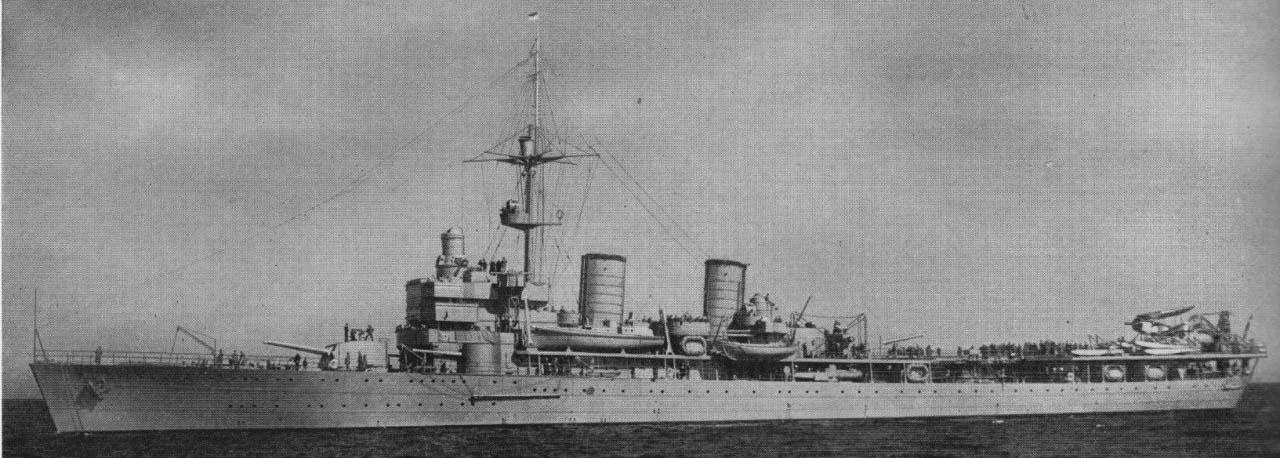
 Seaplane carrier hybrid light cruiser
Seaplane carrier hybrid light cruiser
The singular HSwMS Gotland was designed during the interwar as a jack of all trades, built on a shoestring budget, typical of the post-1929 crisis state of military budgets across europe. A bit like the Dutch Tromp class built afterwards, she was supposed to fill many roles at once. Sweden remaining neutral, HSwMS Gotland never met the chance to test her metal in WW2, probably for the best, but at least was the first to spot the Bismarck… She remained an interesting design that was never repeated (before helicopters became a thing): The Flygpanskryssare.
Development of the HSwMS Gotland (1925-30)
Aviation took a rapid pace before, during and after WWI, and in 1915 already, Sweden had its first naval aviation air division. Ten years after, in 1925, the ministry of defense ordered the creation of the Swedish Air Force (Svenska flygvapnet) in turn. When first starting designing a ship to carry aircraft, it was intended that these would be used as protection for the cruiser herself. But it was concluded that the aircraft were not suitable for it, due to average performances at the time, and Instead, they were retasked to be used as support artillery spotting and reconnaissance. Furthermore, these seaplanes were also to be used to lay out smoke curtains to hide nearby ships from the enemy in wartime.
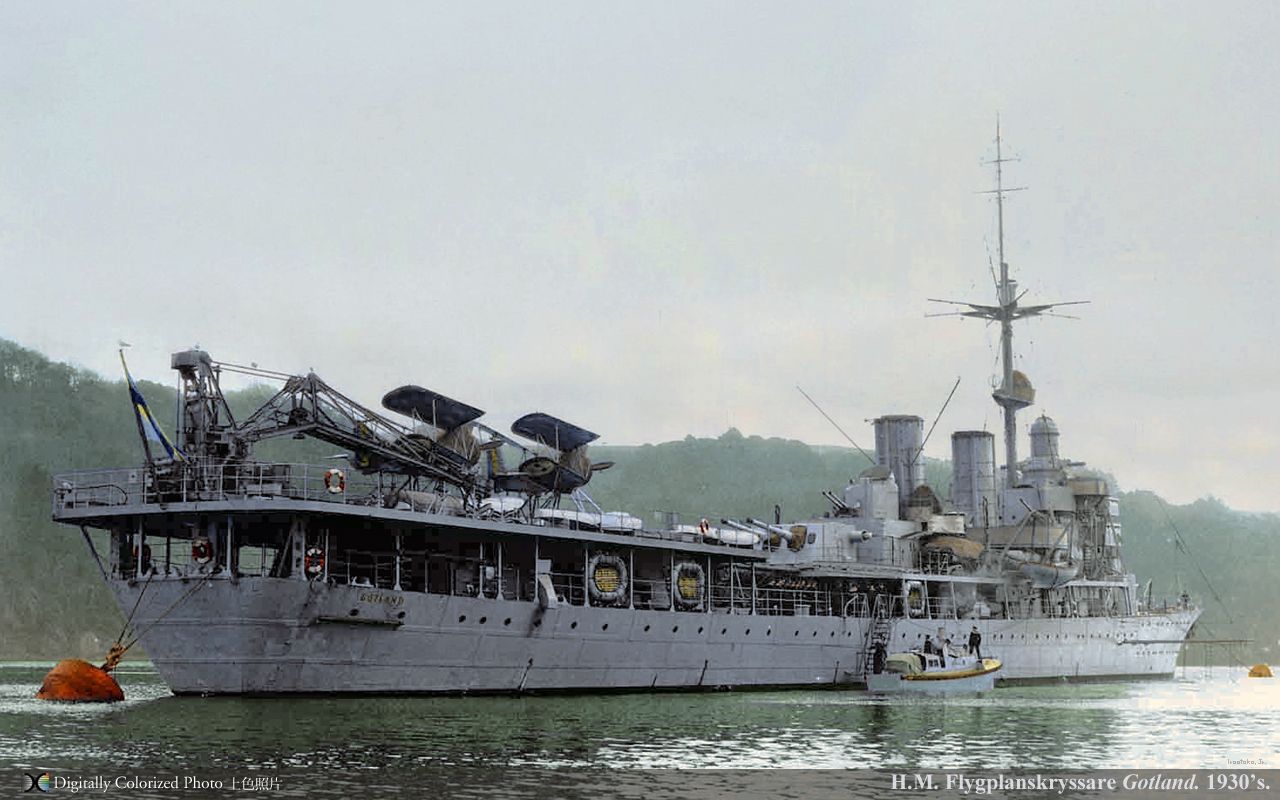
HMS Gotland in the late 1930s, colorized by irootoko jr.
In 1925, a committee as a result of these early prospects was appointed to prepare a proposal, for a new type of cruiser designed to carry and operate aircraft. The study considered desirable to procure two cruisers. From there, several proposals were prepared. None however was completed, as soon the admiralty wanted a larger and more versatile cruiser. The committee later came up with a new proposal, in which the future ship had an in-built hangar large enough to house up to twelve aircraft in between the hangar and the deck. However, aircraft were getting sturdier and no longer needed to be protected by a hangar, so the idea was dropped for a smaller deck without hangar where all planes were to be stored and operated on the stern deck, protected under canvas when not in use. This was ended with a proposal for a ship of 5,500 tons, eight aircraft, 29 knots.
There were back-and-forth discussions about what roles that next cruiser built by Sweden should take, still during the design process. The last Swedish cruiser has been HSwMS Fylgia, a 1904 armored cruiser, scheduled for modernization. Discussions about the role of the new hypothetic cruiser also happened as the bulk of the Swedish Navy comprised coastal battleships divisions and torpedo boats, plus new upcoming destroyers. So it was found adequate to create a cruiser mainly used for scouting duties, so light, fast, with the advanced reconnaissance capabilities procured by its onboard aviation. Although some wanted a cheaper fleet of converted cargo ships used as seaplane carriers, there was one at the other end, the idea of a small aircraft carrier (which will resurface during WW2 and by then traduced into a full concept). The admiralty eventually settled the following year on a compromise: A seaplane carrier/cruiser, which can perform both missions, reconnaissance and leading destroyers.
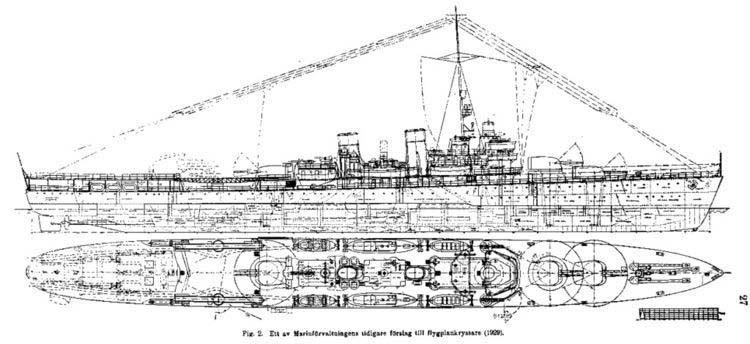
Initial design, before the cruiser was cut down and lightened. The two forward turrets and catapults can be seen.
Once the concept was settled by late 1926 and agreed upon, proper design started out in December 1926. The new cruiser, still unnamed at that point, was to be as a seaplane carrier large enough to carry twelve aircraft. The design was presented to Sweden’s Naval Construction Board, but the latter decided that the new cruiser needed to have minelaying capabilities as well, so a third role. The resulting 5,000-ton design was entirely reworked and eventually presented a month later in January 1927. It proved impossible to build however within the available budget of 16.5 million Swedish Crowns.
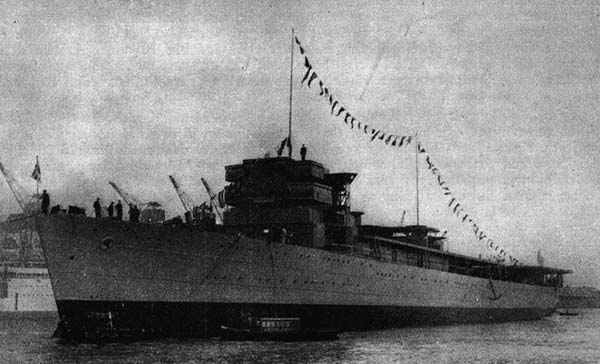
Goland’s launch in 1933
Tenders were received from various shipyards, but it was found that the budget allocated was simply not be enough for the construction. It was necessary shorten the hull of 10 meters, making it 700 tons lighter, and reduced top speed down to 27.5 knots. The biggest change was the dropped superfiring forward turret, the remaining guns replaced in casemates. Last change, just one axial catapult was kept instead of the two side catapults initially planned. Modifications were made to stick to the initial specifications and the yard winning was Götaverken, in Gothenburg. Reduced in size the casemated guns cruiser was reminiscent of the earlier USN Omaha class cruisers, and really unique at that time. The Riskdag eventually voted the budget in 1929, before economical crisis was striking, and construction contract was issued on 7 June 1930. The new ship was to be named HSwMS Gotland, after the island of the same name.
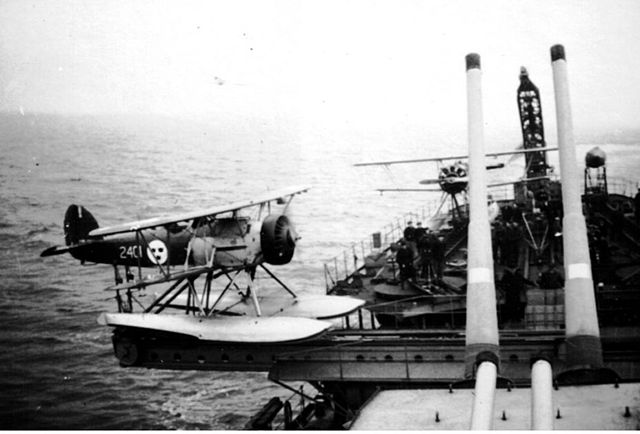
Hawker Osprey S 9, ready for launch on HSwMS Gotland
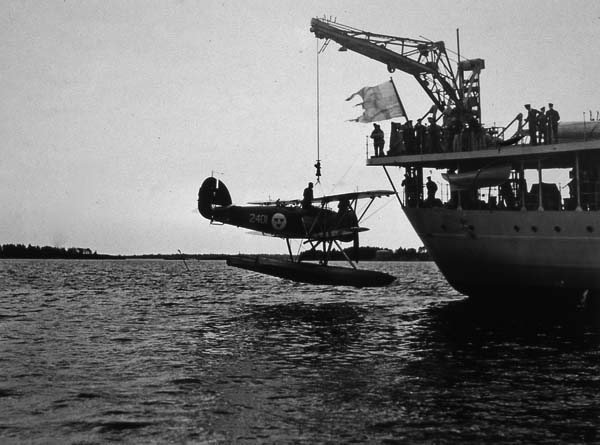
Hawker Osprey S 9 recovered by the stern crane
Design of the HSwMS Gotland
Hull & protection
Gotland’s hull was assembled of riveted steel plates, although the shipyard proposed to weld the hull instead in order to save weight. The Navy considered however this method too untried at the time and declined. This is strange, because in Germany in 1926-27 the “K” class cruisers were using this construction technique. After pool model tests, engineers decided that a hull with lower water resistance needed a bow bulb, and right angle between sides and bottom. The engineers aslo went against long-helf traditions for the officers’ quarters by moving them from the stern to the foreship, where they could be faster on the brigde. In total, the crew amounted to 400 men and general accomodations were relatively spartan due to its limited size.
Protection was very limited: The belt was just 24 mm thick with an upper section of 15 mm (0.6 in), the main armored deck was 25 mm or 1 inch thick and turrets were also protected by 25 mm of armour plates for the frontal arc. The front conning tower was just 19 mm (0.7 in). Figures for the roof are not known. Also, by design, ASW protection included a double hull and the sides were all highly divided into a multitude of watertight compartments. There was however no proper blast-absorbing zone.
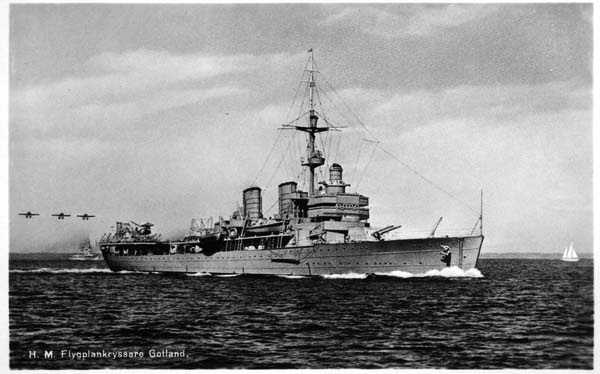
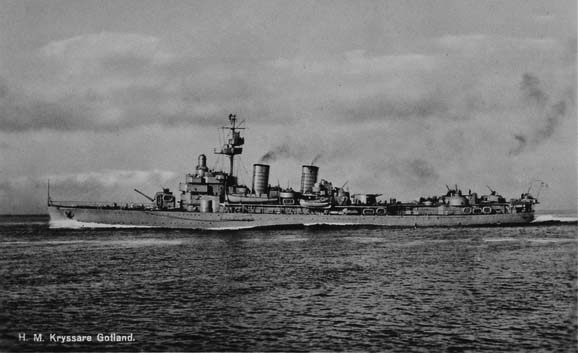
Propulsion
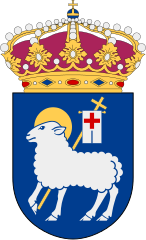 Gotland’s machinery was a further development of the Ehrensköld class destroyer propulsion. Four Penhoët oil-fired steam boilers ere chosen to bring steam to two de Laval steam turbines. Both ran a single propeller. Each boiler, but also and each turbine had its own separate compartment with bulkheads. Total output combined was estimated by engineers to be around 33,000 horsepower, for a projected speed of 27.5 knots. This was achieved on trials. The ship’s electrical systems were also fed by four generators. Two were powered by diesel engines (notably to be usable when machinery was cold, at anchor), and the remainder by the main De Laval steam turbines. Gotland was a long cruiser, long range vessel for which an evaporator was installed to produce fresh water, from desalted seawater. At that point she could carry 800 tones of fuel oil in peacetime conditions, of which 760 were usable, and an extra 80 tons in a reserve tank. This gave her a 4,000 nautical miles range, a bit short for a cruiser, albeit confined to the Baltic and north sea. This fare not well to contemporary cruisers, such as HMS which had the same armament on paper but with 64,000 ship reached 32 knots and had a better range. It should be noted also because the hull was shortened because of budget constraints, the ratio became less favourable for high speed: 130/15 m so about 9/1.
Gotland’s machinery was a further development of the Ehrensköld class destroyer propulsion. Four Penhoët oil-fired steam boilers ere chosen to bring steam to two de Laval steam turbines. Both ran a single propeller. Each boiler, but also and each turbine had its own separate compartment with bulkheads. Total output combined was estimated by engineers to be around 33,000 horsepower, for a projected speed of 27.5 knots. This was achieved on trials. The ship’s electrical systems were also fed by four generators. Two were powered by diesel engines (notably to be usable when machinery was cold, at anchor), and the remainder by the main De Laval steam turbines. Gotland was a long cruiser, long range vessel for which an evaporator was installed to produce fresh water, from desalted seawater. At that point she could carry 800 tones of fuel oil in peacetime conditions, of which 760 were usable, and an extra 80 tons in a reserve tank. This gave her a 4,000 nautical miles range, a bit short for a cruiser, albeit confined to the Baltic and north sea. This fare not well to contemporary cruisers, such as HMS which had the same armament on paper but with 64,000 ship reached 32 knots and had a better range. It should be noted also because the hull was shortened because of budget constraints, the ratio became less favourable for high speed: 130/15 m so about 9/1.

Yard Model at the Sjoehistoriska Museet
Equipments also included six projectors, four for detection and two for morse code and signal lamps, flares, four rowing boats, two small cabin boats aft of the superstructure and two main cabin boats on either side of the fore funnel.
Armament
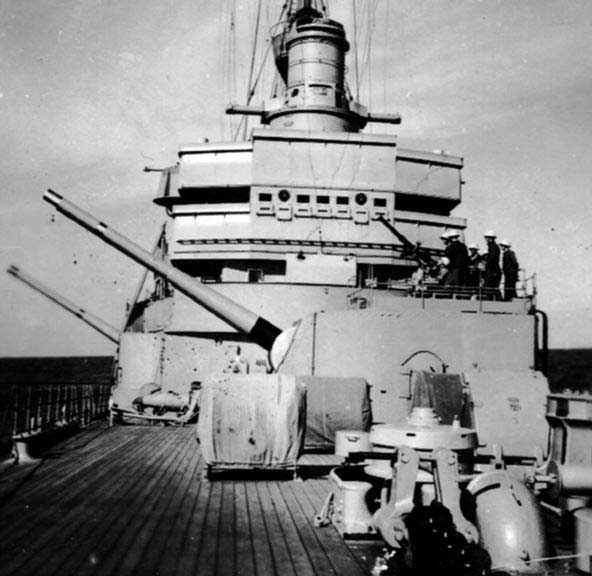
15 cm main guns at max elevation.
Main artillery:
Six 15.2 cm guns M/30, 55 caliber Bofors (6-inches). Four were installed in twin turrets, a single on the foredeck (two initially), and the second on the upper deck after the funnels, due to the aft part of the ship being reserved to aviation. The initial turret was replaced by two casemate guns on either side of the superstructure bridge, and about 150° arc of fire. This made for four guns forward, five boradside and two aft, but in back fire, the turret was right in front of planes, either on the catapult or stern deck rails, limiting its use to broadside fire. The turret guns elevated 60 degrees, allowing them AA fire, far less of course for casemate guns. Their maximum range at this max elevation was 18,000 meters. They were assisted by two main fire directors, one in forward and one aft. The front one was setup mostly to direct AA fire. There was no intermediate caliber.
AA artillery:
Air defense comprised a set of four 75 mm anti-aircraft guns (3-in), one in a single twin mount 60 caliber Bofors Lvk M/28 placed on the upper deck between the funnel, aft telemeter and aft turret. There were also two single mounts M/26 located on each side of a platfom raised between funnels.
Guidance was provided by telemeters located on either side of the bridge superstructure, traversed by hand. To this medium range AA was added a complement for short range of four single 25 mm automatic cannons m/32 which were manned by a special firing control director. These were placed one on each side of the bridge and aft of the superstructure. In addition the ships carried for anti-mine warfare four paravanes, placed on the deck, two forward of the twin turret, and on either side of the casemated guns.
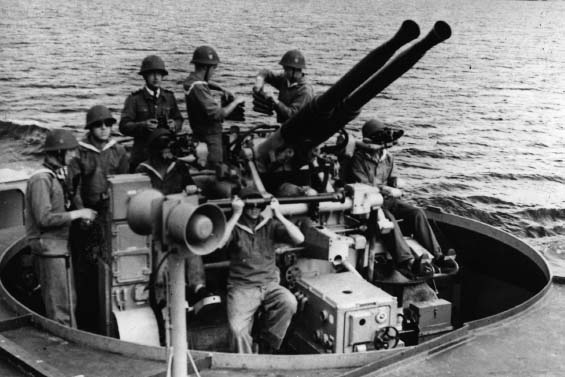
Bofors AA guns after being rearmed in 1945
For close defense, Gotland also carried six torpedoes, placed in two triple banks, on either side of the aft deckhouse. Eventually, engineers were even able to fit mine rails on the stern deck, so some could be carried ande dropped over the stern, but far less than initially planned, when the rails went on for most of the deck. It is not known if this equipment was ever used, since it was planned for wartime.
Aviation onboard
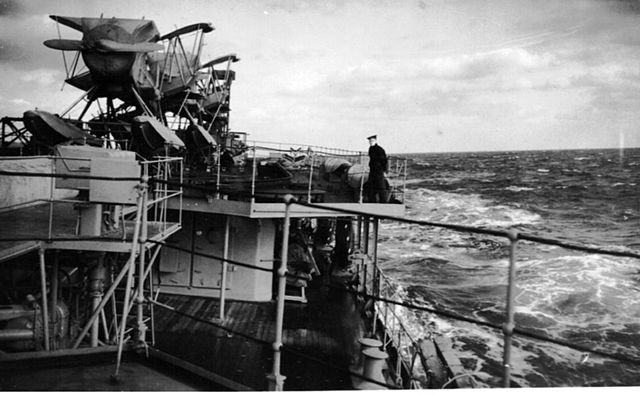
The main advantage of this cruiser, which armament was as consequent as an Arethusa class cruiser, was its onboard aviation, the core design concept from 1926. First off, there was a swiveling catapult installed just aft of turret N°2. Planes were planed on its via the aft deck rails posts, and it can traverse and launch a seaplane, then pivot again in the axis to load another seaplane, launching all its aviation in short time. There were two cranes to lift seaplanes on board: The main aft lattice crane, in the axis and installed at the stern, and a smaller boom crane placed on rails to be moved around the deck. They were served by 60 men, up to eight pilots and replacement and their crews, plus maintenance teams and officers.

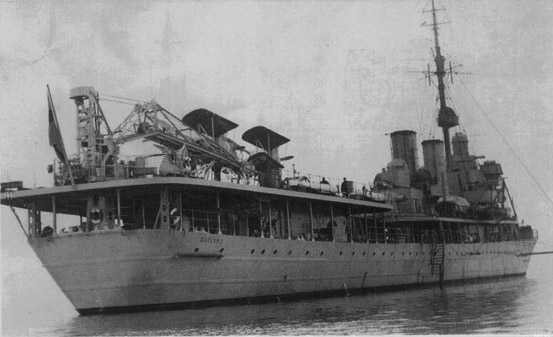
The aft deck was a platform criss-crossed by three railings, one axial and two on either side, completed by three pivoting platforms allowing to move the planes in any direction. If eight aircraft could be carried in normal use, if wartime there was enough tracks to carry three more on board, but in such cases the catapult was locked in place. The first planes to be use were sea biplanes of which only six were carried. In the unfolded position, the catapult useful track lenght was 22 meter long. This runway could hydraulically propel seaplanes at 100 kph by means of compressed air. For the anecdote, the catapult was never formally approval by the naval administration, and still it was used for the whole early career of the ship.
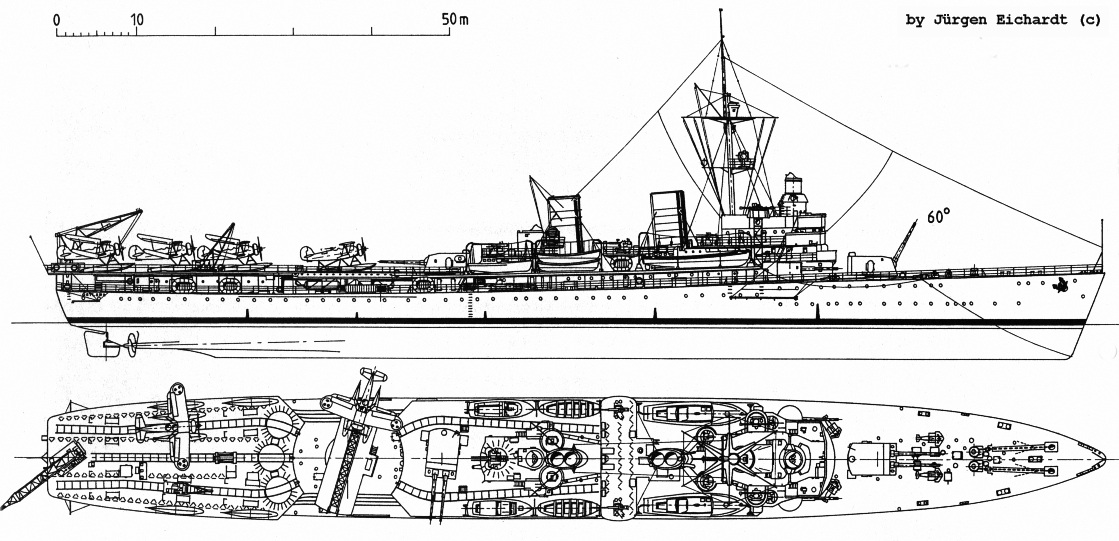
The models used were Hawker Osprey seaplanes, with extra capacity for eight but attempts to purchase them ended when the factory in UK announced its production was terminated. These aircraft had no hangar to be housed into and proved to suffer badly from seawater spray and even wave damage in rough weather, to the point they could be entirely destroyed. It already happened the cruiser went back to port after such event and most its air complement knocked off. This air group did not changed until WW2. It was obvious in 1944 that it was completely obsolete, and because no modern model existed as replacement, it was decided to get rid of these entirely (see below).
⚙ Specifications 1935
| Displacement | 4,600t standard, 5,500t FL |
| Dimensions | 134.80 x 15.40 x 4.50 m (442 x 50 x 15ft) |
| Propulsion | 2 shaft geared turbines, 4 boilers, 28,000 hp. |
| Speed | 27.5 knots (50.9 km/h; 31.6 mph) |
| Range | see notes |
| Armament | 6 x 152 mm (2×2, 2×1) 6-in
-4 x 75 mm (3 in) -4 x 25 mm AA (1.2 in) -2×3 533 mm TTs (21 in) |
| Armor | belt: 24,15, deck 25, turrets 25, CT 19 mm |
| Aviation | 6-8x Oprey S 6 floatplanes |
| Crew | 467+60 air crew |
HSwMS Gotland in service
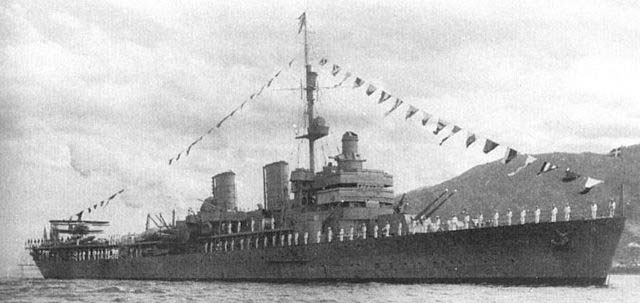
Gotland in 1936
HSwMS Gotland’s interwar career
HSwMS Gotland was launched on 14 September 1933 at Götaverken and completed, then commissioned on 14 December 1934 with the Swedish Navy, after long trials where she reached 27.53 knots based on 32,768 shp. Her second captain, in 1936–1937 was Helge Strömbäck: He helped training the ship further and start fleet exercises. The training routine went on in 1937–1938 under Gösta Odqvist and in 1938–1938 under Erik Samuelson. The interwar saw her taking part in many training cruises around the world: South America and West Africa among others. In normal conditions she stayed in the Baltic.
- 1936 cruise
- Karlskrona 18 November 1936
- Southampton November 1936
- Funchal, Madeira December 2-10
- Saint Vincent, Caribbean, December
- Bridgetown, Barbados December 23-30
- 1937 cruise
- La Guaira, Venezuela January 2-8
- Willemstad, Dutch Caribbean (?)
- Barranquilla, Colombia January 11-14
- Kingston, Jamaica January 17-23
- Pigeon Island, Jamaica (January)
- Veracruz, Mexico February 5-11
- Havana, Cuba February 16-22
- Port au Prince, Haiti (February)
- Kingston, Jamaica (February)
- Ciuadad Trujillo, Dominican Republic February 27-March 1
- Port of Spain, Trinidad and Tobago March 5-12
- Saint Vincent March 21
- Falmouth, England March 31-April 2 and back to Karlskrona
- Hakefjorden (January ?)
- Falmouth, England December 6-9
- Funchal, Madeira December 16
- 1938 cruise
- Dakar, Senegal January 7-10
- Porto Grande, São Vincente, Santo Nicolas (Cape Verde) January
- Dakar, Senegal February 3-7
- Funchal, Madeira (?)
- Agadir, Morocco February 10-17
- Casablanca, Morocco (?)
- Portsmouth, February 23
- Edinburgh, Scotland and back to Karlskrona
- Antwerp, Belgium June 10-15
- Tromsø, Norway June 22-25
- Esbjerg, Norway June 29-July 1 and back to Karlskrona
- Lisbon, Portugal December 14-19
- Porto Santo, Madeira December 22-26
- 1939 cruise
- Porto Grande, Cape Verde, January 1
- Recife, Brazil (?)
- Bahia, Brazil January 9-14
- Santos, Brazil January 19-22
- Buenos Aires, Argentina, January 27-February 4
- Montevideo, Uruguay February 9-13
- Rio de Janeiro, Brazil February 18-25
- Dakar, Senegal March 8
- Funchal, Madeira March 13-20
- Plymouth, March 24-28
- Karlskrona April 4
- Bordeaux, France June 21-26
- Belle Île, France June 27-29
- Southampton June 30-July 4
- Kristiansand, Norway July 13, 1939 and back to Karlskrona.
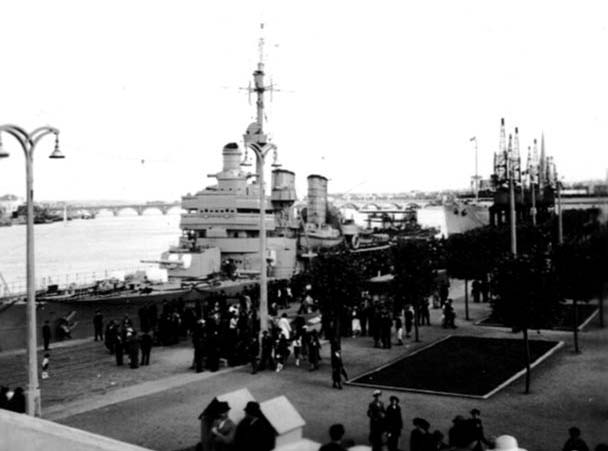
Gotland in Bordeaux, France, 1939.
HSwMS Gotland in WW2
Nothing much happened from September 1939 to early 1941 but year and a half of neutrality patrols, trying to enforce Swedish waters neutrality with a very active Royal Navy and German Navy. She was part of the coast fleet and became a part-time cadet training ship. She saw therefeore no cruises, nor large scale manoeuvers, staying on coastal patrol lines, but venturing into the Skagerrak as well.
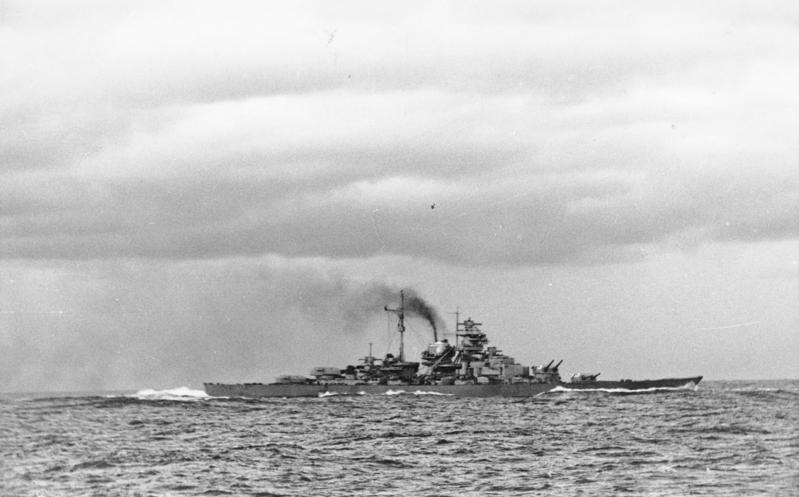
Bismarck in the Denmark Strait
And because of this, in May 1941, HSwMS Gotland was embroiled in one of the most famous naval event of that year in this hemisphere: She sighted the German battleship Bismarck when she went from the Baltic Sea, en route to the Skagerrak. KMS Bismarck and her “task force” indeed previously departed at 2:00 AM on 19 May, from Gotenhafen, and heading for the Skaggerak (Denmark strait). She was joined at 11:25 by the heavy cruiser KMS Prinz Eugen, and three destroyers (Z10, Z16 and Z23, and minesweepers to open a way in known and unknown minefields. The Luftwaffe also provided cover until it was no longer over German waters. On 20 May early in the morning, the flotilla was spotted by a squadron of 10-12 Swedish aircraft flying reconnaissance planes. This was the first alert reported and passed to British Intelligence.

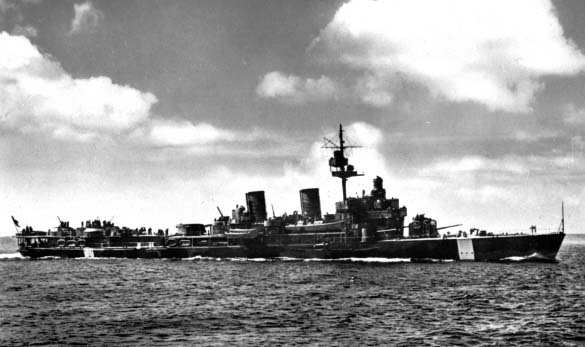
Gotland had a camouflaged livery and white neutrality bands during WW2
The passage of Kattegat proper seen out Swedish cruiser spotting in turn, and then shadowing for two hours the flotilla along the way in the Kattegat. The cruiser transmitted the following report to the Swedish naval headquarters: “Two large ships, three destroyers, five escort vessels, and 10–12 aircraft passed Marstrand, course 205°/20′.” At that point both Lütjens and Lindemann knew their secrecy probably vanished, fering leaks to British intelligence, which indeed happened. The report reached Capt. Henry Denham’s hands (British naval attaché to Sweden). It was then confirmed by the Code-breakers at Bletchley Park based on previous informations. The previous aerial spotting was reported to Swedish Navy headquarters and intercepted by the British embassy.
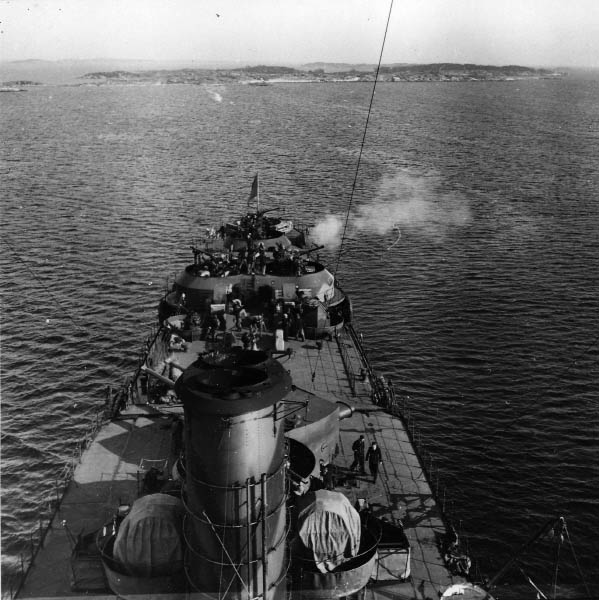
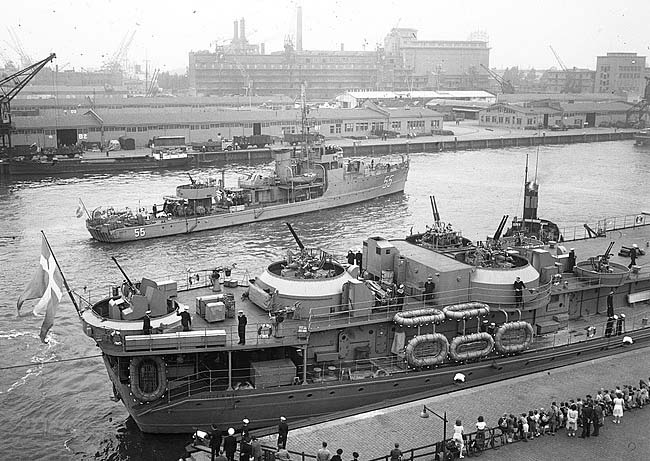
Years passed uneventful for the cruiser, in 1942 and 1943, and up to 1944, when the situation was tense enough war became an option. Her last wartime captain was Moje Östberg, until 1945. The admiralty knowing the completely obsolete air group and general concept of the cruiser being of no use in modern naval warfare decided to convert her as a pure AA cruiser. Not only because much better replacement cruisers were on their way (the Tre Kronor class in construction at that time), but also because Gotland’s slow speed was not ideal for the new plans of the Swedish admiralty, based on two fast cruisers task forces. It was decided that she would be converted that year, 1944, as an anti-aircraft cruiser. Another point was lack of modern seaplanes to replace those in service since 1936. The removal of seaplane facilities was completed by the addition of four 40 mm Bofors guns, and two 20mm L/70 guns placed on the now open aft deck: Two aft in the axis and four on the sides. The old Ospreys were transferred to costal naval service operating from harbour bases. The last were retired on 2 December 1947.
Specifications 1944
| Speed | 26 knots (50.9 km/h; 31.6 mph) |
| Armament | 6 x 152 mm (2×2, 2×1) 6-in
-4 x 75 mm (3 in) -4 x 25 mm AA (1.2 in) -4 x 2 40mm AA -2 x 2 20mm AA |
| Aviation | None |
| Crew | circa 480 |
Post-WW2 service
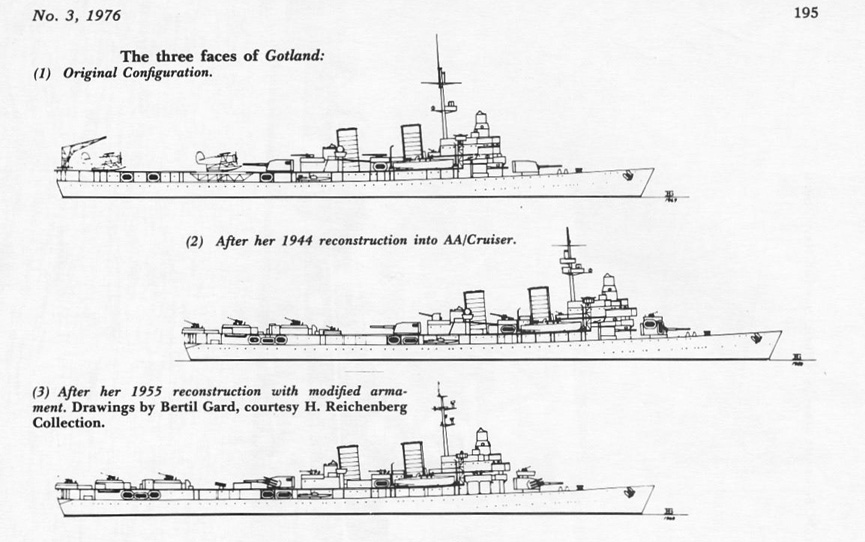
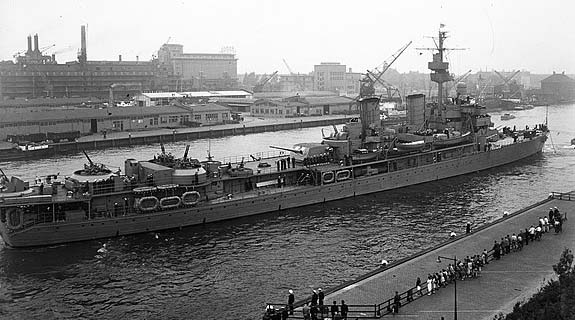

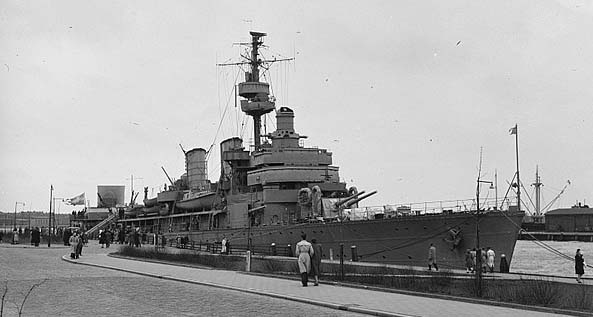
She had as captains Henning Hammargren (1946–1947), Erik Friberg until 1949 and Sven Hermelin until 1951, then in 1955–1956 after refit, Magnus Hammar. After World War II, HSwMS Gotland was relegated as a training ship. She however still cruised the world: In 1947 she visited Malmö, Göteborg, Le Havre (FR), Lyme Bay in England, Torquay, Glasgow and Oban in Scotland. In 1948-49, she stopped in Falmouth, Porto Grande (Cape Verde), Takoradi (Ghana), Banana (Begian Congo), The Cape, Durban (South Af), Lourenço Marques in Mozambique, Mombasa in Kenya, Aden, Djibouti, Port Said, Alexandria, Tunis, Rotterdam, and back to Sweden. In 1950, Lisbon, Porto Santo (Madeira) and Funchal, Port of Spain (Trinidad) and Kingston, Jamaica, Annapolis in Maryland (her first visit of the USA), Port Hamilton in Bermuda, Bordeaux on her way back to Karlskrona, her home port. She later visited Belfast and Brest during the summer.
In 1952-53 her top speed was barely 25-26 knots as her powerplant was worn out. The admiralty decided to convert her again: Starting in 1953 and completed in 1954 she was transformed as a fighter direction ship. This was in for wartime, but she was optimized to serve as a training ship in peacetime. She was eventually decommissioned in 1956, and stricken from the naval register in 1960. Sold on auction in 1962, she was scrapped in 1963, after nearly thirty years of loyal service.
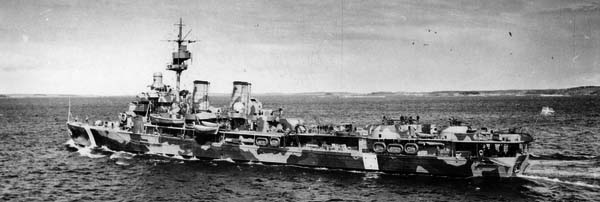
ONI depiction of the ship after her 1950s refit
Specifications 1954
| Speed | 26 knots (50.9 km/h; 31.6 mph) |
| Armament | 2×2 152 mm (6 in)
-4 x 75mm/56 (3 in) -4×2 40mm AA -1×2 25mm AA -5x 20mm AA |
| Electronics | Surveillance Radar |
| Crew | circa 480 |
Sources/Read More
Layman, R.D; McLaughlin, Stephen (1991). The Hybrid Warship The Amalgamation of Big Guns and Aircraft. Conway Maritime Press. p. 40.
Preston, Antony (2002). The World’s Worst Warships. Conway Maritime Press.
Anderson, R. M. (1977). “Re: Gotland”. Warship International. XIV (2): 97.
Westerlund, Karl-Erik (1977). “Re: The HMS Gotland”. Warship International. XIV (2)
“From Northern Waters” 1936 Flight article on Gotland’s aircraft operations
World Aircraft Carriers List: Sweden
Swedish Ship Involved – Aircraft Cruiser – HMS Gotland

ONI depiction of the ship after her 1950s refit


 Latest Facebook Entry -
Latest Facebook Entry -  X(Tweeter) Naval Encyclopedia's deck archive
X(Tweeter) Naval Encyclopedia's deck archive Instagram (@navalencyc)
Instagram (@navalencyc)





 French Navy
French Navy Royal Navy
Royal Navy Russian Navy
Russian Navy Armada Espanola
Armada Espanola Austrian Navy
Austrian Navy K.u.K. Kriegsmarine
K.u.K. Kriegsmarine Dansk Marine
Dansk Marine Nautiko Hellenon
Nautiko Hellenon Koninklije Marine 1870
Koninklije Marine 1870 Marinha do Brasil
Marinha do Brasil Osmanlı Donanması
Osmanlı Donanması Marina Do Peru
Marina Do Peru Marinha do Portugal
Marinha do Portugal Regia Marina 1870
Regia Marina 1870 Nihhon Kaigun 1870
Nihhon Kaigun 1870 Preußische Marine 1870
Preußische Marine 1870 Russkiy Flot 1870
Russkiy Flot 1870 Svenska marinen
Svenska marinen Søværnet
Søværnet Union Navy
Union Navy Confederate Navy
Confederate Navy Armada de Argentina
Armada de Argentina Imperial Chinese Navy
Imperial Chinese Navy Marinha do Portugal
Marinha do Portugal Mexico
Mexico Kaiserliche Marine
Kaiserliche Marine 1898 US Navy
1898 US Navy Sovietskiy Flot
Sovietskiy Flot Royal Canadian Navy
Royal Canadian Navy Royal Australian Navy
Royal Australian Navy RNZN Fleet
RNZN Fleet Chinese Navy 1937
Chinese Navy 1937 Kriegsmarine
Kriegsmarine Chilean Navy
Chilean Navy Danish Navy
Danish Navy Finnish Navy
Finnish Navy Hellenic Navy
Hellenic Navy Polish Navy
Polish Navy Romanian Navy
Romanian Navy Turkish Navy
Turkish Navy Royal Yugoslav Navy
Royal Yugoslav Navy Royal Thai Navy
Royal Thai Navy Minor Navies
Minor Navies Albania
Albania Austria
Austria Belgium
Belgium Columbia
Columbia Costa Rica
Costa Rica Cuba
Cuba Czechoslovakia
Czechoslovakia Dominican Republic
Dominican Republic Haiti
Haiti Hungary
Hungary Honduras
Honduras Estonia
Estonia Iceland
Iceland Eire
Eire Equador
Equador Iran
Iran Iraq
Iraq Latvia
Latvia Liberia
Liberia Lithuania
Lithuania Mandchukuo
Mandchukuo Morocco
Morocco Nicaragua
Nicaragua Persia
Persia San Salvador
San Salvador Sarawak
Sarawak Uruguay
Uruguay Venezuela
Venezuela Zanzibar
Zanzibar Warsaw Pact Navies
Warsaw Pact Navies Bulgaria
Bulgaria Hungary
Hungary

 Bundesmarine
Bundesmarine Dutch Navy
Dutch Navy Hellenic Navy
Hellenic Navy Marina Militare
Marina Militare Yugoslav Navy
Yugoslav Navy Chinese Navy
Chinese Navy Indian Navy
Indian Navy Indonesian Navy
Indonesian Navy JMSDF
JMSDF North Korean Navy
North Korean Navy Pakistani Navy
Pakistani Navy Philippines Navy
Philippines Navy ROKN
ROKN Rep. of Singapore Navy
Rep. of Singapore Navy Taiwanese Navy
Taiwanese Navy IDF Navy
IDF Navy Saudi Navy
Saudi Navy Royal New Zealand Navy
Royal New Zealand Navy Egyptian Navy
Egyptian Navy South African Navy
South African Navy






























 Ukrainian Navy
Ukrainian Navy dbodesign
dbodesign
Gotland was too small to be a successful seaplane carrier, and hardly fast enough to challenge the new generation of German light cruisers being developed in the 1930’s. The fragility of the HAwker Oprey also made the role of Gotland as a seaplane carrier problematic.